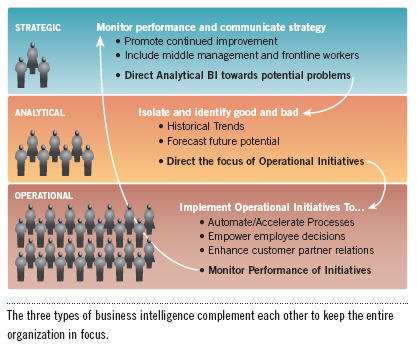
Lesson from the Experts: Three Essential Components of an Enterprise Reporting Environment
Enterprise reporting environments aredesigned to support many types of userswith ad hoc query, reporting, and online analytical processing (OLAP) capabilities. Usefulas these tools have become, however, manyorganizations fail to deploy them properly orto fully understand their power.
 How Strategic, Analytic, andOperational Busines IntelligenceWork Together within an Organization
How Strategic, Analytic, andOperational Busines IntelligenceWork Together within an OrganizationBy Kevin Quinn, Vice President of Product Marketing, Information Builders
Enterprise reporting environments are designed to support many types of users with ad hoc query, reporting, and online analytical processing (OLAP) capabilities. Useful as these tools have become, however, many organizations fail to deploy them properly or to fully understand their power.
The biggest issue is accessibility: You need to make it easy for users to get the information they need. Casual business users don’t want to spend time trying to figure out the structure of database cubes or learn sophisticated analytical software. They want to access information with a couple of clicks, ideally in conjunction with familiar tools such as e-mail programs, search engines, Web browsers, and spreadsheets.
Companies that are successful with their BI initiatives understand how different people use information. Employees need information they can use immediately and understand readily, in a form that suits their requirements. Industry experts commonly acknowledge three levels of business intelligence: strategic, analytical, and operational. While unique in their own way, they are not mutually exclusive. They should be directly connected to each other, working in concert. Strategic analysis drives analytical BI, while analytical BI directs the focus of operational initiatives.
For example, senior executives are concerned with strategy and results. Thus the primary goal of strategic business intelligence is to drive the performance of the company as a whole, as well as the individual departments and business units that produce and deliver the company’s products or services. That generally means highly summarized, functional reports delivered through a portal, dashboard, or balanced scorecard interface.
While strategic BI sets the foundation in the form of key performance metrics, analytical BI is employed to identify the source of an issue once it has been uncovered. Line of business managers responsible for analyzing the performance of their departments need to know why certain events occurred or did not occur. For example, if customer churn rates are rising, is it because of poor product quality or lack of success in customer loyalty initiatives? With analytical BI, companies can investigate the factors that affect business performance from many different angles.
The results obtained from analytical BI activities then drive operational initiatives. Operational business intelligence facilitates the kind of day-to-day decision-making that happens at the lower levels of an organization and enables the attainment of strategic goals. These BI applications must be simple, straightforward, and ubiquitous. They succeed by making operational information actionable, and they support critical business processes through their integration of realtime or near-real-time data into the context of daily activities.
Not every BI product has the right capabilities to create these distinct types of information systems. For example, analytically focused BI products typically don’t scale well, they don’t read all the data sources you might have, and they can’t combine different back-end sources into a cohesive presentation. A complete enterprise reporting environment must be able to access data on the fly in native formats and combine dissimilar data types. It should not require a data warehouse; rather, it should be able to directly access data in production information systems. Technically, this implies strong integration capabilities and a thinclient, browser-based architecture that can efficiently deliver information to thousands or even tens of thousands of people.
For a free white paper on this topic, click here and choose the title “How Business Intelligence Should Work.” For more information about Information Builders, click here.
Next
Previous
Back to Table of Contents